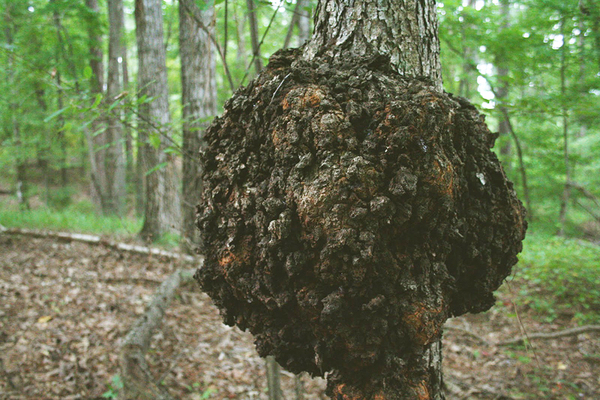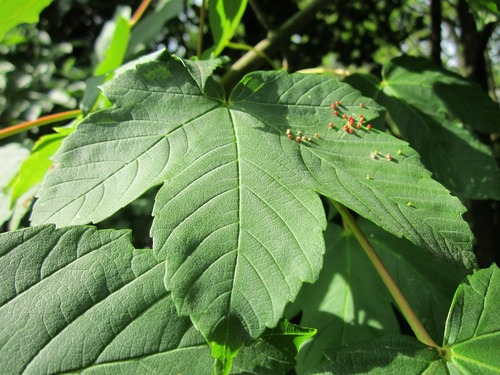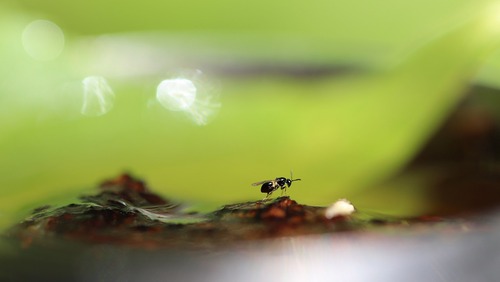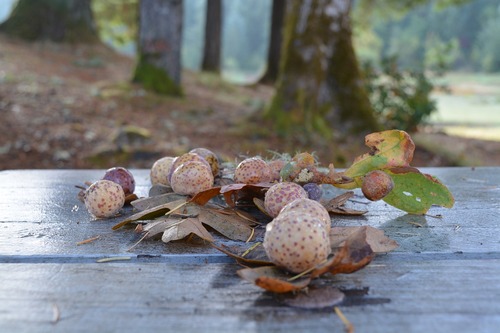Bizarre Lumps, Bumps, and Growths in Your Yard!

Understanding and Managing Galls: Unusual Growths in Plants
Welcome to a comprehensive guide on galls—those enigmatic, often perplexing growths found on plants and trees. In pursuing a pristine garden, encountering peculiar lumps, bumps, or abnormal structures might leave you wondering about their origin and impact on plant health. Fear not! This article delves into the world of galls, shedding light on their causes and effects, and offering effective management strategies.
Galls, these intriguing outgrowths appearing on leaves, twigs, or roots, are products of various factors—from insect activity to infections by bacteria or fungi. Often mistaken as natural components of plants, these formations, from oak apple galls to maple bladder galls, exhibit diverse colors and shapes, contributing to their mysteriousness.
This comprehensive guide explores the diversity of galls, from their origins to their impact on different plant species. Discover preventative measures, innovative management tactics, and even imaginative uses for removed galls. Let's unravel the mysteries and empower you to keep your garden thriving, free from the concerns of these unusual growths.
What Are Galls?
Galls are abnormal outgrowths found on various parts of many plants, including leaves, twigs, roots, or flowers. They're primarily caused by inflammatory reactions to insects, such as aphids, midges, wasps, or mites, that feed or lay eggs on the plant. Infections by bacteria, fungi, or nematodes can also induce gall formations often resembling those caused by insects.
The Diversity of Galls
These growths exhibit various colors, from red and green to yellow and black, adding to their mystique. Factors like weather conditions, plant susceptibility, and pest populations affect the occurrence of galls from year to year and influence their appearance . Oaks in particular are prone to hosting insects that cause various types of galls, leading many to mistake them for natural parts of the tree.
Exploring Gall Diversity and Effects

A Cluster of Maple Leaf Galls
Oak Galls
Location and Appearance: Oaks showcase a wide variety of gall-related deformities across different parts of the tree. These galls can be found on leaves, twigs, flowers, acorns, and buds, and they vary significantly in size, shape, and color. Galls are so commonly found on oaks that it is often thought that galls are typical parts of the plants. Some of the most common oak galls include:
- Oak Apple Galls: Large, round, and spongy structures often found on oak leaves, caused by wasps. They start out green and mature into brown or black.
- Horned Oak Galls: Elongated, horn-shaped growths that protrude from twigs, caused by wasps. They can appear in various shades of brown.
- Knopper Galls: Distinctive, acorn-like growths that develop on oak twigs, caused by wasps. They start out green and eventually turn brown.
Maple Bladder-Gall
Location and Appearance: This particular gall, observed as bright red bead-like growths on silver and red maple leaves, is caused by eriophyid mites. These mites feed within the galls, changing the galls' color from green to reddish, then to nearly black by the end of summer. By fall, the mites have left the foliage to overwinter on the twigs, usually at the bases of the buds.
Crown Gall
Location and Appearance: As noted by the Morton Arboretum in Illinois, crown gall is one of the most studied plant diseases. The disease is caused by a soil-inhabiting bacterium. More than 600 plant species in over 90 plant families are susceptible to this disease, although relatively few species sustain significant damage. Galls form on roots and stems, especially at the root collar—the junction of roots and stem. Young plants with large or numerous galls tend to be stunted and predisposed to drought damage or winter injury. Galls continue to enlarge as plants grow and can disfigure woody stems.
Prevention Tactics for Gall Management
Taking proactive measures can significantly reduce the occurrence and impact of galls on your trees:
Early Detection and Inspection
- Regular Checks: Conduct routine inspections to detect early signs of gall formation, enabling timely intervention.
- Vigilance: Monitor vulnerable trees closely, especially during seasons when gall-causing insects are active.
Optimal Planting and Care
- Tree Selection: Consider planting gall-resistant tree varieties to minimize susceptibility.
- Healthy Practices: Maintain optimal tree health through proper watering, fertilization, and pruning to bolster their natural defenses against pests.
Companion Planting Strategies
- Deterrent Plants: Introduce companion plants that repel gall-causing insects. For instance, planting alliums or chives around susceptible trees may deter pests.
Understanding Gall Insects' Life Cycles

A Close-up of a Small Flying Insect on a Branch - Photo by Nennieinszweidrei on Pixabay
Understanding the life cycles of common gall-causing insects is crucial for targeted treatment:
Common Gall Insects and Optimal Treatment Timing
- Gall Wasps: These insects lay eggs on plants during specific seasons. Treatments targeting adult wasps should be initiated before egg-laying periods.
- Gall Midges and Gall Aphids: Their life cycles involve specific stages like larvae or nymphs. Target treatments to coincide with the emergence of these stages to prevent infestations.
Tree Species' Susceptibility to Galls
Certain tree species are more prone to gall formations due to various reasons:
Factors Influencing Susceptibility:
- Tree Genetics: Some tree species have inherent vulnerabilities to specific gall-causing insects due to their genetic makeup.
- Environmental Conditions: Trees stressed by unfavorable conditions like poor soil, drought, or inadequate nutrients are more susceptible.
- Insect Preferences: Certain insects have specific preferences for particular tree species, causing higher occurrences of galls.
Commonly Susceptible Tree Species:
- Oak Trees: Among the most susceptible, oak trees host a wide variety of gall-causing insects due to their favorable habitat and diverse range of species.
- Maple Trees: Certain maple species, such as silver and red maples, are more prone to gall infestations, especially by mites.
- Walnut Trees: Gall formation via bacteria has been shown to be common in California walnut groves.
Though not a tree, it is worth mentioning that rose bushes are also quite susceptible to gall formation, primarily due to aphids and other insects.
Geographical Influences on Gall Occurrences

An Oak Leaf Gall - Photo by Leo_65 on Pixabay
Gall occurrences are influenced by various climatic factors and regional environments:
Areas and Climates
- Humid Regions: Areas with high humidity often experience increased gall occurrences due to favorable conditions for insect breeding and activity.
- Temperate Zones: Temperate climates with diverse tree species might witness a wider variety of gall types owing to the presence of various gall-causing insects.
- Urban vs. Rural: Urban areas with diverse landscapes might see different gall occurrences compared to rural or forested regions.
Maintenance and Treatment Recommendations
For existing gall issues, employing specific maintenance and treatment methods is essential:
Pruning and Removal
- Timing: Prune galls during dormant seasons or late winter/early spring to minimize stress on trees.
- Technique: Use sterilized pruning tools to cut at least 6 inches below the affected area. Dispose of pruned parts properly to prevent further infestation.
Avoiding Chemical Treatments
- Ineffectiveness: Chemical sprays are often ineffective as they don't reach pests protected within galls.
- Risk: Sprays can harm beneficial insects and the environment, making them an unsuitable option for gall management.
Promoting Tree Health Post-Gall Damage
- Fertilization: Apply balanced fertilizers to aid in the recovery of damaged trees.
- Mulching: Use organic mulch to retain moisture and improve soil health around affected trees.
- Monitoring: Regularly inspect trees for signs of regrowth and monitor for any reoccurrence of galls.
Innovative Uses of Removed Galls

A Collection of Leaf Galls on a Picnic Table - Photo by Daniela Morescalchio on Pixabay
Transforming Peculiar Growths into Functional and Artistic Marvels
Once removed from trees, galls reveal a world of creative possibilities and practical applications, turning these curious growths into functional elements and artistic mediums.
Crafts with Galls
- Natural Decorations: Embrace the unique shapes and textures of galls in your creative endeavors. Use them in flower arrangements, wreaths, or centerpieces for an intriguing natural touch.
- Carved Décor: Larger warty oak galls offer an exceptional carving medium. Sculpt them into decorative bowls, vases, or sculptural elements, adding an organic and distinctive flair to your space.
- Miniature Creations: Explore the hollow interiors of select galls for crafting miniature terrariums or captivating displays with miniatures nestled inside.
Harnessing Galls for Natural Dyes
- Vibrant Pigments: Certain galls produce a spectrum of vivid pigments, ranging from reds and blues to purples, oranges, and blacks. Grind and soak removed galls to extract these captivating colors.
- Crafting with Botanical Hues: Use these natural dyes to color wool, linen, paper, or other craft projects, infusing them with stunning botanical tones.
Ink Production from Galls
- Rich Inks: Galls, especially oak galls, yield pigments capable of producing deep, rich inks. The iron salts present in oak galls react with tannins, historically creating profound black inks extensively used for writing and drawing purposes.
Tinting with Gall Powders
- Artistic Tinting: Incorporate powdered galls into various mediums such as paints, wood stains, epoxy resin, or even hair dye. Their addition in small amounts can impart amber, brown, or gray hues, enhancing artistic expression and functionality.
Exploring Historical Medicinal Uses
- Ancient Remedies: Historically, dried galls were employed for their astringent properties and in treating specific ailments. Delve into research to understand their proper use in health remedies should you seek a deeper understanding of their historical medicinal applications.
Discover the versatility of removed galls, transforming them from unusual tree growths into elements of artistic expression, practical craftsmanship, and historical intrigue.
Conclusion

A Large, Healthy Tree with a Green Canopy - Photo by PublicDomainPictures on Pixabay
In conclusion, understanding the nature and management of galls is vital for maintaining the health and beauty of your garden. Despite their peculiar appearance, most galls pose minimal threats to plant health. Armed with knowledge about their causes and effects, proactive measures can be taken to mitigate their impact on your green space.
Implementing early detection through routine checks, choosing gall-resistant tree varieties, and fostering optimal tree health are key steps in gall management. Additionally, exploring the life cycles of common gall-causing insects and understanding tree species susceptibilities empowers effective targeted treatments. For severe or recurring gall issues, seeking guidance from certified arborists or plant specialists is highly recommended. Their expertise ensures accurate diagnosis and tailored solutions, safeguarding your garden's vitality.
Transforming removed galls into functional or artistic elements showcases their versatility, turning unusual growths into intriguing mediums for natural dyes, crafting, and historical exploration. With these insights and practical strategies, you're equipped to nurture a vibrant and gall-resistant garden that thrives against the backdrop of nature's mysteries.
Originally posted on July 6, 2021





